Sesame seeds are a great addition to everyday cooking. They are known for their nutty flavor and delicious crunch. But did you know that with a few simple steps, you can transform them into an even better version?
Sprouted seeds offer several benefits that make them a great addition to your diet. It increases nutrition availability and improves digestibility. Sprouting can also boost the antioxidant content of seeds and elevate levels of certain vitamins.
I’m not a food blogger (although I love cooking), so let’s stick to the gardening part and look at how to sprout sesame seeds. One thing I will repeat multiple times during this article is cleanliness! It’s important to keep everything clean and duly prepared, or your sesame seeds are at risk of growing unwanted bacteria. Keep sanitation in mind for the whole journey, and let’s take a look at how to sprout sesame seeds at home.
What does it Mean to Sprout Sesame Seeds?
Let’s go to the basics first. What does it even mean to sprout seeds?
Sprouting is the early stage of a seed’s growth, where it begins to germinate and sprout a tiny shoot. The seed absorbs moisture we give it (or it gets from the soil around it), and the outer protective layer softens. This moisture triggers the seeds to awaken and start the germination process, breaking down complex compounds.
If you were to plant these germinated sesame seeds, you could potentially grow a sesame plant and have an infinite supply of sesame seeds! But that’s a much harder process and would take nearly half a year to get there.
Can you Sprout Sesame Seeds from the Store?
Yes, you can certainly sprout sesame seeds that you’ve purchased from the store. In fact, many people choose to sprout store-bought sesame seeds because it’s a convenient way to enjoy the benefits of sprouted seeds without the need for a garden or special equipment.
Sometimes, sesame from the grocery store can have an issue to sprout successfully. After all, you can’t be sure if the seed wasn’t heat treated or how long it is on the shelf.
That’s not a big deal since we’ll be using a lot of seeds, and it doesn’t matter if some of them don’t sprout. But to higher your chances, I recommend selecting raw and unhulled seeds.
How Long does it Take for Sesame Seeds to Sprout?
The time it takes for sesame seeds to sprout can vary depending on various actors, but they will be ready to eat in less than a week. It generally takes only 2 to 4 days to see little white-ish sprouts.
How to Sprout Sesame Seeds
So how do you sprout sesame seeds? Easily! Let’s take a look.
1. Select your Seeds and Rinse them
To kick off the sprouting process, the first step is to carefully select your sesame seeds. You can skip this step, but removing any damaged or unhealthy seeds from the pack right away can higher your success rate.
I usually don’t measure them, I just use whatever amount feels right, depending on my chosen container. As a rule of thumb, I’d like to fill the container to one-third with sesame seeds.
But before you do that, make sure to give them a thorough rinse under cool, running water to remove any dust, dirt, or other impurities.
2. Put the Sesame Seeds on a Sprouting Tray
Once you’ve rinsed your sesame seeds, make sure to drain any excess water and transfer them directly onto a sprouting tray. A sprouting tray is a multi-layer container designed for sprouting seeds. To put it very simply, it’s a tray with mesh to allow drainage and aeration.
If you don’t own one, you can substitute it with anything that allows the same. For instance, you can use a mason jar with cheesecloth on top, where the lid normally goes. However, in that case, it’s important to keep the jar tilted or at an angle to allow excess water to drain out.
As a last resort, you can also use just a container without any drainage. But there’s a higher risk of mold or fungal growth.
3. Rinse and Drain Regularly
Make sure the seeds don’t dry out. Visit the sprouting tray (or your DIY alternative) often to rinse it. By that, I mean every 4 to 12 hours. If you’re using a regular tray without drainage, simply spray the seeds with water.
4. Harvest the Sesame Sprouts
Rinse, drain, and repeat until your sesame seeds sprout and reach your desired length. That’s really a thing of preference. Some people let them sprout for only one day. I usually leave it for about two days, longer than that, they taste bitter to me.
If you are sprouting sesame for the first time, you can taste it regularly to find what suits you the best. Make sure not to leave them sprouting for too long; otherwise, there is a risk of mold.
After you find your ideal sprout age, take them off their container and dry them properly. These can be stored in a fridge for up to two weeks, but they will slowly get more bitter the longer they are in storage.
Sesame Seed Sprouts Benefits
Sesame seed sprouts offer a wealth of benefits. They are nutrient-packed, containing essential vitamins, minerals and antioxidants.
Sprouting sesame seeds enhances their nutrient bioavailability, making it easier for your body to absorb and utilize these vital nutrients compared to regular sesame seeds. Additionally, the sprouting process can improve digestibility by breaking down complex compounds.
Sprouted sesame seeds often have higher levels of certain nutrients, including B vitamins, vitamin C, calcium, and iron, compared to their un-sprouted counterparts.
And let’s not forget that sprouts have their own unique texture and taste, which can be ideal in dishes where sesame seeds don’t find their place.
Before you go…
Sesame seeds and sprouts are not the only fresh, seedy addition to your kitchen. You can also very easily grow mustard seeds from, well, mustard seeds. Make sure to check out my other article to find out how…
Planting Mustard Seeds from the Grocery Store? Yes & Here’s How











